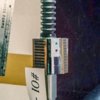Nah, I was talking about the LED plate. I got the feeling they would have chamfered the entire length of the box and the LED plate interrupts the pattern.
I still am interpreting the prop as having a box with a curved bottom. the radius of the box doesn't look exactly the same as the radius of the saber. A hair wider, maybe.
hey, if they didn't chamfer the bottom edges, the box would extend further around the saber (hug it more) and maybe they wanted the box to not go down that far.
I still am interpreting the prop as having a box with a curved bottom. the radius of the box doesn't look exactly the same as the radius of the saber. A hair wider, maybe.
hey, if they didn't chamfer the bottom edges, the box would extend further around the saber (hug it more) and maybe they wanted the box to not go down that far.

